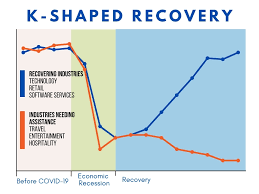CURRENT AFFAIRS
Get the most updated and recent current affair content on Padhaikaro.com
Pointers that India is witnessing a K-shaped Recovery
- IAS NEXT, Lucknow
- 26, Nov 2021

Reference news:
The pointers are indicating that India is witnessing a K shaped recovery more than V-shaped with various groups and industries recovering much more rapidly than their counterparts.
What shapes of economic theory are in debate?
- V-shaped recovery – A V-shaped recovery is characterized by a quick and sustained recovery in measures of economic performance after a sharp economic decline.
- Such recoveries are generally spurred by rapid readjustment of consumer demand and business investment spending.
- Because of the speed of economic adjustment and recovery in macroeconomic performance, a V-shaped recovery is a best-case scenario given the recession.
- The recoveries that followed the recessions of 1920-21 and 1953 in the U.S. are examples of V-shaped recoveries.
- The Economic Survey 2021 predicted a ‘V-shaped’ post-pandemic recovery.
- The recovery in FY22 is indeed V-shaped after the first quarter because of 20 % expansion – a sharp upturn after a quick decline.
V-shaped-recovery
- K-shaped recovery – A K-shaped recovery is one in which the performance of different parts of the economy diverges like the arms of the letter “K”.
- In a K-shaped recovery some parts of the economy may see strong growth while others continue to decline.
- Overall, the natural consequence of a pandemic is the widening of inequality and a K-shaped recovery.
- Education, for example, is inherently K-shaped in many places and this has become even more skewed due to Covid-19.
- A K-shaped recovery exhibits wealth inequality, greater corporate monopolies, a continuing racial wealth gap, long-term unemployment for low-income workers, and accelerating technological adoption.
k-shaped-recovery
- What indicates that the economy is witnessing K shaped recovery?
- Signs from industry – The effects of this K-shaped recovery can be observed through the growth and consumption in specific industries.
- A report by CRISIL indicates that in the year 2021, two-wheeler sales are set to decline by 3%-6% year-over-year on top of a lower base in the year 2020.
- The sales of two-wheelers are the second-lowest it has been in seven years and the festival season was unable to rectify this phenomenon.
- On the other hand, premium cars and premium motorcycles have been resistant to the pandemic slowdown.
- Impact of taxation – The taxation policy of the Government insists on maintaining indirect taxes on fuel and consumer products while lowering corporate taxes.
- While inflation soars, the incomes of the middle and lower-middle-class have at best remained constant leading to a sustained loss in disposable income.
- On jobs – Over five million people lost their jobs in October, according to a Centre for Monitoring Indian Economy (CMIE) report.
- Unemployment coupled with the high food and fuel prices push families into poverty.
- On NREGA – There is a greater demand now for MGNREGA jobs than in the pre-COVID-19 era.
- But, in 2021-2022, the Government had cut its budget allocation towards MGNREGA by 34% for its inability to compensate workers in time and fairly.
- People who are looking for MGNREGA work cannot afford to be unpaid for such long durations and this again ties back to placing upward pressure on unemployment figures.
Stimulus and growth – The recovery in the stock market and other such financial assets over the past year has been phenomenal but only less than 5% of India directly benefited from the said recovery.
- The lower middle class which does not invest in such assets has no guard against inflation and their only hedge against inflation is their income.
- The disproportional benefit of the asset price inflation favouring the upper-middle-class further displays the inherent K-shape of the recovery.
How can the Government address this phenomenon?
- The U.S. and European economies have stimulated the economy bottom-up through unemployment cheques and social welfare schemes.
- It is crucial that the Government addresses this phenomenon and works towards aiding the middle and lower-middle class.
- It is essential to prioritise those who are more likely to spend (the middle and lower-middle-class) rather than those who have a greater propensity to save.
- Social welfare schemes must be given greater importance to assist households to get through this period.
- The velocity of money which sustained a significant shock from pandemic lockdowns needs to be kickstarted.
- The Government needs to increase the progressive (direct) taxes and reduce the regressive (indirect) taxes to ease the financial pressure on lower-income households.